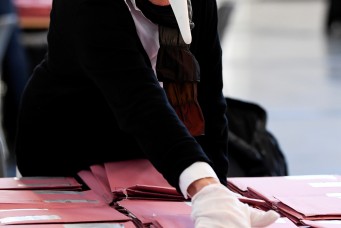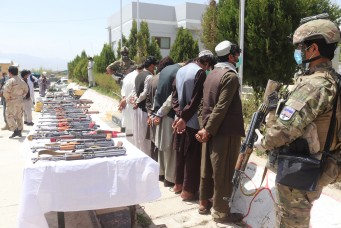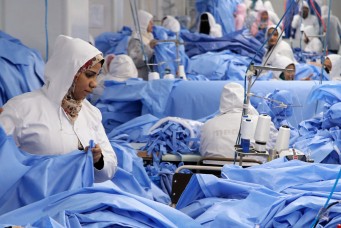Capturing the Invisible: Photojournalism during COVID-19
Photojournalism had a pandemic reckoning, inviting artistic elements to coexist with traditional reportage. The newest exhibit at The Photographic Gallery displays both side by side.

A visitor takes photographs at the RHS Chelsea Flower Show, delayed from its usual spring dates because of lockdown restrictions amid the spread of the coronavirus disease (COVID-19) pandemic, London, Britain, September 21, 2021. Toby Melville/Reuters
COVID-19 has created both a challenge and a reckoning for contemporary photojournalists to find creative and conceptual methods to continue narrative storytelling. Nearly two years since the onset of the pandemic, photojournalists, whose jobs were once focused on documenting world events as they happened, are caught between continuing that style of work or adapting to the new conditions.
This month’s dual exhibition at The Photographic Gallery, housed in AUC’s School of Global Affairs and Public Policy’s department of Journalism and Mass Communication, “tells the story of the year 2020 but in a conceptual and creative way,” the gallery’s curator, Dina ElDeeb said. The exhibit is currently displaying the works of two emerging Egyptian photographers, Ali Zaraay and Ahmed Gaber. “They reveal two opposite sides that complete each other.”
Gaber’s work documents the Black Lives Matter (BLM) protests in New York in 2020, while Zaraay’s dream-like images depict the isolation, estrangement, and loneliness of the pandemic from Hanover, Germany. The exhibition juxtaposes a classic photojournalistic style with an emerging artistic one reflective of the universal condition experienced by everyone during the past two years, namely “pandemic life,” said guest speaker and Photo Director of The New Republic Stephanie Heimann. “No matter who is looking at these pictures, we are all sharing that experience,” Heimann stated. “Our global lockdown is a traumatic experience that we all shared as global citizens…Is there anything else that really compares in our lifetimes?”
Photojournalism and COVID-19
It was, and sometimes remains, difficult to send photographers to take traditional portraits as unprecedented questions arise. Heimann rattled off a list, including whether or not both parties were vaccinated, immunocompromised, or if the subjects had children in the house. While some political events have increased the safety risks for photojournalists—the BLM protests (two of her photographers were hit in the eye with rubber bullets) and the January 6 insurrection at the Capitol building in Washington, D.C. being but a few examples—at the end of the day, the threat of contracting COVID is always present, Heimann said. She emphasized that photojournalists must remember that regardless of genre and style, they are the ones required to be on the frontlines.
Heimann sees that every photographer’s goal should be to affect policy change on frontline issues. This requires that they make personal sacrifices in pursuit of their craft. Citing the example of photographers whose images helped convict war criminals following the Balkan conflicts in the 1990s, she argued that while concrete policy change may not be the result, photojournalism “is doing something to help move the world”. As “witnesses to history” U.S. photographers Ron Haviv and Christopher Morris who covered the conflicts across former Yugoslavia, captured the death and destruction of the conflict, which was later used as evidence in trials against war criminal suspects.
(Re)Defining the Medium
Zaraay’s work opens up a discussion on what to expect from photojournalists. While Gaber’s work follows a more traditional example of photojournalism, Zaraay combines artistic and reportage elements to shatter the traditional expectations of how the “decisive moment”—the action moment traditional photojournalism aims to capture—looks like.
Both exhibits are full of information and communication, Heimann said; however, “the stories themselves are not always visual by nature.” While the BLM images are visual, with evident violence, fear, and conflict captured in moments of protest, Zaraay’s imagery is an introspective form of communication through a different genre of photography that many photojournalists were forced into during the pandemic, she added.
This complication extends to gallery curators such as ElDeeb as well, who posed the question: “How do you tell the story about a deadly pandemic and an invisible subject, apart from showing masks, or people in masks?” The answer was in presenting two bodies of work that reflected the opposite experiences of lockdown. They complement each other, with Zaraay’s work being more personal and introspective and Gaber’s work relying on observational or documentary techniques of outside events.
For example, Gaber’s high-contrast work depicts action scenes soaked in shadows with heightened emotion evident throughout. Precarious angles, showing protesters from above or below at a diagonal, find gallery-goers tilting their heads left and right to interact with the motion of the photographs. Featuring several portraits of protesters chanting, with their hands raised or tears in their eyes, viewers confront the violence and fear of the protests and the BLM movement, preserved in a split second.
Heimann also introduced the concept of visual vocabulary, using an example of a photo essay by photojournalist Chris de Bode which depicts famine by documenting the amount of food families ate in a single day. “There’s a challenge in trying to find a new way for people to look at an image, especially if it’s something you’re expecting,” Heimann said. In serious contexts such as war, famine, or grief, being bombarded with the same types of images can lead viewers to become exhausted with them. “There’s a lot of resonance and power to telling stories in the non-traditional way,” she emphasized.
In Zaraay’s photographs, he presents a creative, internal representation of lockdown life. Due to pandemic restrictions, photojournalists have a renewed focus on still life, the representation of family members through technology, or nature, Heimann said, all of which are present in Zaraay’s work. His use of double exposure and multilayering seems to fracture reality, presenting an array of aesthetic manifestations, Ronnie Close, an associate professor in the Department of Journalism and Mass Communication who attended the event, said.
Zaraay’s pieces depict wanderings through nature, video calls with loved ones, and everyday scenery. Four portraits of unnamed young adults are prominently featured, intimately posing in red, green, and natural light. They personify the emotions of the pandemic—shades of love, anxiety, and separation, Heimann said. Artistry became a necessity during the pandemic. “It was like asking everyone to become art photographers,” Heimann explained.
Defining the style of photography—documentary photography versus lens-based photography versus photojournalism—can be a complex and subjective process. Because of the ongoing interplay between art and photojournalism, which is accelerated by the pandemic, a new style is emerging that the industry may not even have a name for, Heimann noted. Consequently, the photographs in the exhibit are displayed without context or captions, only a brief description in the gallery guide.
The Importance of Perspective
In September, The World Press Photo Foundation, an organization which holds annual press photography contests, announced a new competition model for 2022. The organization will aim to increase the level of representation from regions that have been historically underrepresented in their contests. This initiative may help democratize the field, allowing more space for imagery collected on phone cameras or other accessible technologies as opposed to high-end equipment, which poses prohibitive cost barriers.
“It would make it easier for citizens to tell their own stories,” Heimann argued. She added that the updated model may also help combat parachute journalism—a phenomenon where reporters “drop in” to a country for a short period of time, file stories without adequate knowledge of the political or cultural landscape, then leave.
If these channels are able to be opened by initiatives such as these, Heimann said, “we’ll have a better chance at people around the world telling their perspective of their stories.”




